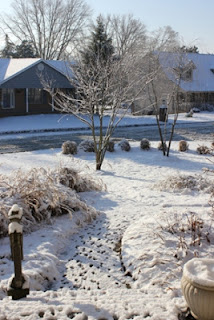 After days of almost constant rain, yesterday around lunchtime the precipitation switched to snow. Several people reported hearing thunder, also. It snowed for several hours, stopping right at sunset and giving many of us a spectacular sky to enjoy from the window. Last night, the temperature dropped to 23, the skies cleared, and this morning the first sun we have seen in days is glistening on the drifts. This was the scene out the front door this morning. It's beautiful to behold, but what a mess!
After days of almost constant rain, yesterday around lunchtime the precipitation switched to snow. Several people reported hearing thunder, also. It snowed for several hours, stopping right at sunset and giving many of us a spectacular sky to enjoy from the window. Last night, the temperature dropped to 23, the skies cleared, and this morning the first sun we have seen in days is glistening on the drifts. This was the scene out the front door this morning. It's beautiful to behold, but what a mess!One hardly thinks of gardening when the ground is blanketed with snow, but now is the time to start seeds for the earliest crops. If you have a small area indoors with enough light, you can start leeks, onions, celery and spinach now.
Gardeners do not automatically think of growing spinach from transplants, but if you only need a small patch for fresh use, transplanting is easier than thinning. Spinach will germinate in cold soil, and will grow with the relatively low energy budget afforded by artificial lighting. Start seeds in 36-cell trays and transplant when they have two pairs of true leaves. Even though transplanting sets them back a bit, giving the young plants proper spacing from the beginning results in larger mature plants and a better overall harvest, in our experience. In good soil, the cultivar 'Bloomsdale,' long the standard around here, will produce leaves the size of ping-pong paddles.
Given its ease of culture, high nutrition levels and amenability to preservation by freezing, spinach is one of the best crops the home gardener can grow. 'Bloomsdale' does well both spring and fall. There is also a 'Winter Bloomsdale' cultivar, said to be best for overwintering in the ground. In colder areas, perhaps this would be an advantage, but 'Bloomsdale' has overwintered successfully here in Zone 6b for the past three winters.
Working With UT Gardens
We recently made a donation of hardy orchid plants to the UT Gardens. The orchids will have a new home this spring in the new shade-garden area. We are excited that our favorite perennial is finally going to be on display for visitors to enjoy. We also hope the public planting will inspire people to try this carefree plant at home. The initial planting will be of the wild type, Bletilla striata, which is pictured on our In The Garden page. We are growing several other cultivars of Bletilla, and we have pledged to add examples to the UT Gardens collection as soon as we have enough plants. These additional donations will take place over the next few years.
My personal thanks to Dr. Sue Hamilton, Director of UT Gardens, her Assistant Director, James Newbern, and Education Director Derrick Stowell. It has been a pleasure working with them all during 2012, and we look forward to continuing that great relationship in 2013.
No comments:
Post a Comment